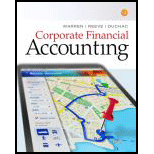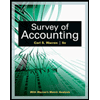
Corporate Financial Accounting
14th Edition
ISBN: 9781305653535
Author: Carl Warren, James M. Reeve, Jonathan Duchac
Publisher: Cengage Learning
expand_more
expand_more
format_list_bulleted
Question
Chapter 3, Problem 3.3ADM
A.
To determine
Vertical analysis:
Vertical analysis is the method of financial statement analysis, and it is useful to evaluating a company’s performance and financial condition. Vertical analysis is helpful for analyzing the changes in the financial statements over the time, and comparing the each item on a financial statement with a total amount from the same statement. In the vertical analysis, the financial statements are analyzed in the following manner:
- In vertical analysis of a
balance sheet , each asset item is stated as a percent of the total asset, and each liability and owner’s equity item is stated as a percent of total liabilities and owner’s equity. - In vertical analysis of an income statement, each item of revenue and expense is stated as a percent of total revenues of the business.
The amount and percentage of change in the net income from year 1 to year 2.
B.
To determine
The percentage relationship between net income and sales of year 2 and year 1.
C.
To determine
To explain: The conclusion drawn from the analysis.
Expert Solution & Answer
Trending nowThis is a popular solution!

Students have asked these similar questions
Solve this question and accounting
If Cost of Goods Sold is $175,000 and the beginning and ending inventory balances are $22,000 and $17,000, respectively, inventory purchases equal:
If the liabilities of a company increased RM75,000 during a period of time and the owner's equity in the company increased RM15,000 during the same period, the assets of the company must have: A. Decreased RM90,000 B. Increased RM60,000 C. Increased RM90,000 D. Decreased RM60,000
Chapter 3 Solutions
Corporate Financial Accounting
Ch. 3 - How are revenues and expenses reported on the...Ch. 3 - Is the matching concept related to (A) the cash...Ch. 3 - Why are adjusting entries needed at the end of an...Ch. 3 - What is the difference between adjusting entries...Ch. 3 - Identify the four different categories of...Ch. 3 - If the effect of the debit portion of an adjusting...Ch. 3 - If the effect of the credit portion of an...Ch. 3 - Prob. 8DQCh. 3 - Prob. 9DQCh. 3 - (A) Explain the purpose of the two accounts:...
Ch. 3 - Account requiring adjustment Indicate with a Yes...Ch. 3 - Type of adjustment Classify the following items as...Ch. 3 - Adjustment for accrued revenues At the end of the...Ch. 3 - Adjustment for accrued expense Prospect Realty Co....Ch. 3 - Adjustment for unearned revenue On June 1, 2018,...Ch. 3 - Adjustment for prepaid expense The prepaid...Ch. 3 - Adjustment for depreciation The estimated amount...Ch. 3 - Effect of omitting adjustments For the year ending...Ch. 3 - Effect of errors on adjusted trial balance For...Ch. 3 - Classifying types of adjustments Classify the...Ch. 3 - Classifying adjusting entries The following...Ch. 3 - Adjusting entry for accrued fees At the end of the...Ch. 3 - Effect on omitting adjusting entry The adjusting...Ch. 3 - Prob. 3.5EXCh. 3 - Prob. 3.6EXCh. 3 - Effect of omitting adjusting entry Accrued...Ch. 3 - Prob. 3.8EXCh. 3 - Adjusting entries for unearned fees The balance in...Ch. 3 - Prob. 3.10EXCh. 3 - Adjusting entry for supplies The balance in the...Ch. 3 - Determining supplies purchased The supplies and...Ch. 3 - Effect of omitting adjusting entry At March 31,...Ch. 3 - Adjusting entries for prepaid insurance The...Ch. 3 - Adjusting entries for prepaid insurance The...Ch. 3 - Adjusting entries for unearned and accrued fees...Ch. 3 - Prob. 3.17EXCh. 3 - Adjustment for depreciation The estimated amount...Ch. 3 - Determining fixed assets book value The balance in...Ch. 3 - Prob. 3.20EXCh. 3 - Effect s of errors on financial statements For a...Ch. 3 - Effects of errors on financial statements For a...Ch. 3 - Effects of errors on financial statements The...Ch. 3 - Effects of errors on financial statements If the...Ch. 3 - Prob. 3.25EXCh. 3 - Adjusting entries from trial balances The...Ch. 3 - Prob. 3.27EXCh. 3 - Adjusting entries On March 31, the following data...Ch. 3 - Prob. 3.2APRCh. 3 - Adjusting entries Reliable Repairs Service, an...Ch. 3 - Adjusting entries Good Note Company specializes in...Ch. 3 - Adjusting entries and adjusted trial balances...Ch. 3 - Adjusting entries and errors At the end of April,...Ch. 3 - Adjusting entries On May 31, the following data...Ch. 3 - Adjusting entries Selected account balances before...Ch. 3 - Adjusting entries Crazy Mountain Outfitters Co.,...Ch. 3 - Adjusting entries The Signage Company specializes...Ch. 3 - Adjusting entries and adjusted trial balances...Ch. 3 - Adjusting entries and errors At the end of August,...Ch. 3 - The unadjusted trial balance that you prepared for...Ch. 3 - Prob. 3.1ADMCh. 3 - Chipotle: Vertical analysis Chipotle Mexican...Ch. 3 - Prob. 3.3ADMCh. 3 - Prob. 3.4ADMCh. 3 - Prob. 3.1TIFCh. 3 - Prob. 3.3TIF
Knowledge Booster
Similar questions
- I need help solving this general accounting question with the proper methodology.arrow_forwardPlease provide the solution to this financial accounting question with accurate financial calculations.arrow_forward(a) The data in the table below has been collected by John Akoth to appraise the performance of four asset management firms: Fund 1 Fund 2 Fund 3 Fund 4 Market Index Return 6.45% 8.96% 9.44% 5.82% 7.60% Beta 0.88 1.02 1.36 0.8 1 Standard Deviation 2.74% 4.54% 3.72% 2.64% 2.80% Required If the risk-free rate of return for the relevant period is 3%, calculate the following: (i) Ex post alpha ratio. (ii) Treynor measure. (iii) Sharpe ratio. (iv) M2. (v) Rank the funds using a radar chart and state which one you would select.arrow_forward
- Do fast answer general accounting questionarrow_forwardThe Bluebird Company has annual sales of $6,800, total debt of $2,200, total equity of $3,400, and a profit margin of 7.5 percent. What is the return on assets? a. 7.25 percent b. 8.96 percent c. 10.18 percent d. 9.11 percent e. 11.45 percentarrow_forwardCan you demonstrate the accurate method for solving this financial accounting question?arrow_forward
- Can you help me solve this general accounting problem using the correct accounting process?arrow_forwardI need guidance with this general accounting problem using the right accounting principles.arrow_forwardWhat were the equivalent units for conversion costs in the Finishing Department for the month?arrow_forward
arrow_back_ios
SEE MORE QUESTIONS
arrow_forward_ios
Recommended textbooks for you
 Financial AccountingAccountingISBN:9781337272124Author:Carl Warren, James M. Reeve, Jonathan DuchacPublisher:Cengage Learning
Financial AccountingAccountingISBN:9781337272124Author:Carl Warren, James M. Reeve, Jonathan DuchacPublisher:Cengage Learning Financial AccountingAccountingISBN:9781305088436Author:Carl Warren, Jim Reeve, Jonathan DuchacPublisher:Cengage Learning
Financial AccountingAccountingISBN:9781305088436Author:Carl Warren, Jim Reeve, Jonathan DuchacPublisher:Cengage Learning Managerial Accounting: The Cornerstone of Busines...AccountingISBN:9781337115773Author:Maryanne M. Mowen, Don R. Hansen, Dan L. HeitgerPublisher:Cengage Learning
Managerial Accounting: The Cornerstone of Busines...AccountingISBN:9781337115773Author:Maryanne M. Mowen, Don R. Hansen, Dan L. HeitgerPublisher:Cengage Learning Managerial AccountingAccountingISBN:9781337912020Author:Carl Warren, Ph.d. Cma William B. TaylerPublisher:South-Western College Pub
Managerial AccountingAccountingISBN:9781337912020Author:Carl Warren, Ph.d. Cma William B. TaylerPublisher:South-Western College Pub College Accounting, Chapters 1-27AccountingISBN:9781337794756Author:HEINTZ, James A.Publisher:Cengage Learning,
College Accounting, Chapters 1-27AccountingISBN:9781337794756Author:HEINTZ, James A.Publisher:Cengage Learning, Survey of Accounting (Accounting I)AccountingISBN:9781305961883Author:Carl WarrenPublisher:Cengage Learning
Survey of Accounting (Accounting I)AccountingISBN:9781305961883Author:Carl WarrenPublisher:Cengage Learning

Financial Accounting
Accounting
ISBN:9781337272124
Author:Carl Warren, James M. Reeve, Jonathan Duchac
Publisher:Cengage Learning

Financial Accounting
Accounting
ISBN:9781305088436
Author:Carl Warren, Jim Reeve, Jonathan Duchac
Publisher:Cengage Learning

Managerial Accounting: The Cornerstone of Busines...
Accounting
ISBN:9781337115773
Author:Maryanne M. Mowen, Don R. Hansen, Dan L. Heitger
Publisher:Cengage Learning

Managerial Accounting
Accounting
ISBN:9781337912020
Author:Carl Warren, Ph.d. Cma William B. Tayler
Publisher:South-Western College Pub

College Accounting, Chapters 1-27
Accounting
ISBN:9781337794756
Author:HEINTZ, James A.
Publisher:Cengage Learning,

Survey of Accounting (Accounting I)
Accounting
ISBN:9781305961883
Author:Carl Warren
Publisher:Cengage Learning